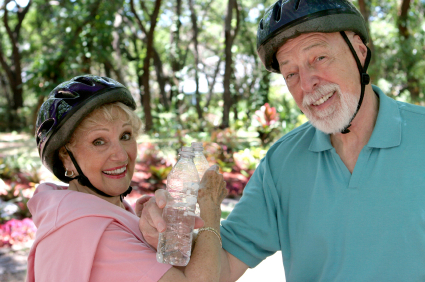By: Trude Carlsen, PhD Candidate at Department of Public Health and Nursing and Department of Circulation and Medical Imaging
Are you in a bad shape, struggling with depressive symptoms, or struggling with both? Our research on 15,000 middle-aged and older people who participated in the Nord-Trøndelag Health Study, shows that improving fitness or depressive symptoms can be very important for our health, even at a higher age.

It is possible to influence our health positively by improving fitness or our depressive symptoms. (Illustration photo: iStock)
Depression is a common mental disorder. More than 350 million people suffer from depression worldwide, and the World Health Organization has rated depression as one of the leading causes of years lived with disability.
Physical and mental health are strongly related. Previous research has found that people with depression or depressive symptoms have an increased risk of premature death and of developing cardiovascular disease. The term premature death may sound brutal, but is often used in research settings and can be interpreted as dying earlier than life expectancy (about 84 years for women and 80 years for men in Norway, figures from the Norwegian Institute of Public Health 2015). We are all going to die, but some will die earlier than expected due to disease, accidents or injury, and that’s what we mean by premature death.
We know that depression is a devastating disorder to our health and we know that high fitness reduces the risk of a variety of diseases, such as cardiovascular disease and mental disorders such as depression and anxiety. We also know that people with high fitness have a lower risk of premature death compared to people with low fitness. What we know less about is how a change in these two factors affects our health and we wanted to investigate further. Can we, influence our health positively by improving fitness or our depressive symptoms when we are 50, 65 or 80 years of age?
Trude Carlsen explaining her research:
Our research shows that it is possible. To determine this, we used the Fitness Calculator developed by the Cardiac Exercise Research Group (CERG) at NTNU to calculate the participants’ fitness. Fitness has been shown to be the key factor to living a long and healthy life. Depressive symptoms were measured using a questionnaire that was handed out to the participants. We obtained information about deaths during the follow-up period through the Norwegian Cause of Death Registry. I want to emphasize that our research focuses on depressive symptoms and not depression as a diagnosis. Examples of depressive symptoms may be frustration, unhappiness, do not engage in usual enjoyable activities, sleep problems, and lack of confidence.
Theese findings were published in the medical journal Mayo Clinic Prooceedings: Long-term Changes in Depressive Symptoms and Estimated Cardiorespiratory Fitness and Risk of All-Cause Mortality: The Nord-Trøndelag Health Study.

Trude Carlsen. (Photo Amanda Gerhardsen)
Not surprisingly, we found that the risk was most reduced among the fit with low depressive symptoms over time. The good news is that those who managed to improve their fitness or managed to reduce their depressive symptoms also reduced the risk of premature death. It seems that it is never too late take action to improve fitness or depressive symptoms at a higher age.
What does it take to improve? Regular physical activity is one of the actions. Physical activity is medicine, it is free and influences health in so many ways other than that we feel happier and become in better shape. When it comes to maintaining high fitness, or improving it, regular physical activity is of paramount importance. Regular physical activity is also shown to improve depressive symptoms. Becoming out of breath and breaking a sweat two to three times a week can do wonders for our health.
Doctors and other health professionals should assess depressive symptoms and fitness regularly in their patients and take action to improve one or the other when necessary. There are simple tools for calculating fitness, and questionnaires to measure depressive symptoms. With help of some simple questions and measurements, healthcare professionals can easily calculate fitness using the Fitness Calculator.
